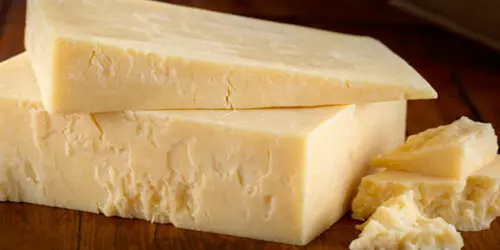Introduction to Types Of Cheeses
When it comes to the Types of Cheeses, the options seem limitless, and each variety brings its own unique character and flavor profile to the table. Whether you’re a seasoned cheese enthusiast or just embarking on your cheesy journey, this comprehensive guide will take you on a delightful tour through some of the most exquisite cheeses the world has to offer. From the creamy goodness of American cheese to the pungent allure of blue cheese, we’ll delve into the details, characteristics, and best uses for each type.
1) American Cheese
American cheese, a mainstay in the United States, is known for its unmatched meltability, super creamy texture, and its ability to elevate any burger to greatness. This cheese is typically more processed than its counterparts and is sometimes crafted with a combination of cheddar and Colby jack cheeses.
American cheese shines when it comes to melting. It’s the ideal choice for a perfect cheeseburger, where its gooey, creamy texture takes center stage. Additionally, it works wonderfully in grilled cheese sandwiches, adding that signature melt-in-your-mouth experience.

2) Asiago Cheese
Asiago cheese, hailing from Italy, comes in two distinct forms: pressed and ripened. Ripened Asiago is a saltier, harder, and more aged cheese that bears a resemblance to Parmesan. Pressed Asiago, on the other hand, is a fresh, mild, and semi-soft cheese.
Incorporate ripened Asiago into your charcuterie board for a savory kick, or sprinkle it over pasta dishes. For a milder, creamier experience, opt for pressed Asiago, which pairs beautifully with fruits like apples or can be used to smother tortellini.

3) Blue Cheese
Blue cheese, famous for its distinctive blue mold, includes varieties like French Roquefort, English Stilton, Italian Gorgonzola, and Spanish Cabrales. It offers a creamy and soft texture, often spreadable, and boasts an intense flavor that divides palates.
The bold and funky flavors of blue cheese are a perfect match for dressing, enhancing the richness of steak, or adding a unique twist to potato salad. It’s a cheese that truly packs a flavorful punch.

4) Brie Cheese
Brie cheese, a soft, spreadable cow’s milk delicacy, is crafted with extra cream to achieve a silky, indulgent texture. This cheese shines when served at room temperature, alongside crusty bread and fruit jam.
Elevate your cheeseboard with Brie, serving it as a centerpiece alongside a selection of fruits and bread. Its creamy texture and mild, buttery flavor make it a perfect pairing for various accoutrements.
5) Burrata Cheese
Burrata, often mistaken for fresh mozzarella, surprises with its creamy interior that resembles cottage cheese. While it looks unassuming on the outside, the moment you slice into it, you’re treated to a delightful surprise.
Enjoy Burrata smeared on a slice of bread or as an essential component in salads. The creamy, slightly tangy filling complements a wide range of dishes, making it a versatile choice for any culinary enthusiast.
6) Camembert Cheese
Camembert, hailing from France, shares similarities with Brie in terms of shape and texture but boasts a more intense, earthy flavor. It might not be as runny or spreadable as Brie, but it pairs nicely with jam.
Camembert is a fine addition to your cheeseboard and complements the sweetness of jam perfectly. Its more pronounced flavor adds depth to the overall tasting experience.
7) Cheddar Cheese
Cheddar cheese, originally from England, is known for its versatility, with variations in texture and flavor. Traditional cheddar is crumbly, sharp, and nutty, while American cheddar is creamy, melty, and mild. Cheddar also comes in varying colors, from white to a deep, buttery yellow.
Cheddar is a classic choice for topping burgers or enhancing potato dishes. Its adaptability makes it suitable for a wide range of recipes, from mac and cheese to savory quiches.
8) Cotija Cheese
Cotija cheese, a dry and crumbly cow’s milk cheese from Mexico, offers a mild, salty zing. It doesn’t melt well, making it perfect for dishes like enchiladas, nachos, tacos, chilaquiles, or posole.
Sprinkle Cotija cheese over your favorite Mexican dishes to add a salty kick and a crumbly texture. It’s a staple in authentic Mexican cuisine, enhancing the flavors of various dishes.
9) Feta Cheese
Feta cheese originates from mainland Greece or Lesbos and is primarily made from sheep’s milk. The curds are soaked in a saltwater brine, giving it a tangy, acidic flavor.
Feta’s tangy and acidic notes make it a fantastic addition to a watermelon salad, where it complements the sweet and salty flavors perfectly. It’s also a star in the viral baked feta pasta, where it delivers a creamy, flavorful punch.
10) Fontina Cheese
Fontina cheese, crafted from cow’s milk, offers a mild and hard texture. While it originated in Italy, it is now also produced in Denmark, Sweden, and the U.S. Young Fontina cheese is creamy, making it ideal for dishes like French onion soup or paninis. Aged selections, on the other hand, have a harder, crumbly texture, making them suitable as finishing cheeses.
Young Fontina cheese is perfect for adding creaminess to French onion soup or enriching a panini. Aged Fontina varieties can be grated and sprinkled over various pasta dishes to enhance their flavor.
11) Goat Cheese
In the U.S., goat cheese, or chèvre, describes a fresh, soft goat’s milk cheese. It’s known for its pungent and bright flavor, often presented in log form.
Goat cheese shines on a charcuterie board, complemented by jam and a selection of cured meats. It also plays well in salads and can be sprinkled atop pasta dishes for a burst of flavor.
12) Gouda
Gouda is a cow’s milk semi-hard to hard cheese that originates in the Netherlands. Its flavor varies based on the duration of aging, with younger Goudas being creamy and mild, and more aged Goudas possessing a sharpness.
Consider adding grated aged Gouda to your pasta dishes to elevate their flavor profile. Its unique taste and texture make it a valuable ingredient in various recipes, like the three-cheese spaghetti recipe.
13) Grana Padano
Grana Padano is Italy’s most-produced cheese, made from skim milk from a cow. It matures faster than Parmesan and can be used in a variety of dishes, from pastas to salads and pizzas.
Substitute Grana Padano in any recipe that calls for Parmesan cheese to enjoy its unique flavor. It’s an excellent choice for enhancing the taste of pasta dishes and adding a savory touch to salads.
14) Halloumi Cheese
Halloumi is one of the few cheeses that retains its shape when grilled. Originating from Cyprus and crafted from sheep’s or goat’s milk, it offers a squeakier, bouncier texture compared to mozzarella. The flavor is tangy and slightly salty, making it an enticing option.
Halloumi is a must-try for grilling enthusiasts. Serve it as a main course or a delightful appetizer. Its unique texture and salty tang make it a standout choice on the grill.
15) Havarti Cheese
Havarti cheese, known for its mild flavor, is an American cow’s milk cheese. It often serves as the base for other cheeses like pepper jack and Colby. It comes in block form, cubes, or slices and is characterized by its white color.
Havarti’s mild flavor makes it a versatile option for a variety of dishes. It works wonderfully in recipes that require a creamy, meltable cheese, such as queso, where it can be used to enhance the overall flavor.
16) Manchego Cheese
Manchego cheese, crafted from sheep’s milk in Spain, is aged for 60 days to two years. It features a hard texture with a buttery flavor and small air pockets throughout.
Manchego cheese shines in grilled cheese sandwiches, potato gratin, or as a delightful addition to a cheese platter. Its unique texture and flavor profile make it a standout choice for those who appreciate bold flavors.
17) Monterey Jack
Monterey Jack, an American cow’s milk cheese, is renowned for its super mild flavor. It often serves as the base for other cheeses like pepper jack and Colby. Typically, it comes in block form, cubes, or slices, and is characterized by its white color.
Monterey Jack is an ideal choice for recipes where a mild, melty cheese is desired. It’s a staple in dishes like queso, where it contributes to the smooth, creamy texture that’s so beloved.
18) Muenster Cheese
Muenster cheese is easily recognizable by its orange exterior, achieved through vegetable coloring during the cheesemaking process. It features a mild and creamy flavor, along with a soft texture.
Muenster cheese, with its mild and creamy profile, is a versatile option for various recipes. It’s excellent when melted on a burger or incorporated into mac and cheese for a comforting, creamy finish.
19) Mozzarella Cheese
Mozzarella, an Italian cheese made from buffalo’s milk, is known for its creamy, mild flavor and its ability to pull apart like string cheese. It’s a staple in dishes like caprese salad and pizza.
Mozzarella cheese is a must for classic Italian recipes. Its creamy texture and mild flavor make it perfect for caprese salads or as the gooey, melty topping on a perfect pizza.
20) Paneer Cheese
Paneer is a fresh cheese made from cow’s or buffalo’s milk and hails from the Indian subcontinent. It doesn’t melt, making it an excellent addition to curries and grilled dishes.
Paneer’s spongy texture makes it a fantastic ingredient for absorbing the flavors of various Indian dishes. Use it in classic recipes like sag paneer, where it adds a delightful contrast to rich, flavorful curries.
In this world of cheese, each variety offers a unique taste, texture, and culinary potential. Whether you’re savoring the creamy indulgence of Brie or embracing the boldness of blue cheese, the vast world of cheese invites exploration and creativity. So, next time you’re at your local deli or cheese shop, don’t hesitate to try something new, and let your taste buds embark on a delightful journey through the realm of cheese.
Conclusion
Types of Cheese is that there is a wide and diverse range of cheese varieties, each with its own distinct characteristics, flavors, and uses. Some popular types include American cheese, known for its meltability and creaminess; Asiago cheese, offering both a saltier, aged version and a fresh, mild variety; Blue cheese, famous for its moldy pockets and intense flavor; Brie cheese, celebrated for its silky, spreadable texture; and Burrata cheese, with its surprise creamy interior. The list continues with Camembert, Cheddar, Cotija, Feta, Fontina, Goat cheese, Gouda, Grana Padano, Halloumi, Havarti, Manchego, Monterey Jack, Muenster, Mozzarella, and Paneer, each contributing its unique taste and texture to the world of cheese.
How many types of cheese are there in the world?
There are over 1,700 recognized types of cheese worldwide. This vast variety of cheese types can be categorized into several broad groups, including fresh, soft, semi-soft, hard, blue, and processed cheeses. Each type of cheese has its unique characteristics, flavors, and uses, making the world of cheese incredibly diverse.
What are the 4 main types of cheese?
The four main types of cheese are typically categorized based on their texture and aging process:
- Fresh Cheese: These cheeses have a high moisture content and are typically unaged. Examples include mozzarella and ricotta.
- Soft Cheese: Soft cheeses are creamy and often have a white, edible rind. Brie and Camembert fall into this category.
- Semi-Soft Cheese: These cheeses are more solid but still have a creamy texture. Gouda and Roquefort are examples.
- Hard Cheese: Hard cheeses have a low moisture content and are aged for an extended period. Cheddar and Parmesan are well-known hard cheeses.
